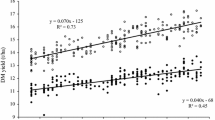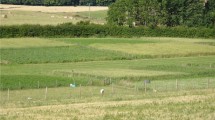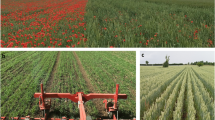Abstract
This study shows an average yield increase of 415–1,338 kg ha−1 per unit increase of the Shannon diversity index for feed barley cultivar use. There is a global quest to increase food production sustainably. Therefore, judicious farmer choices such as selection of crop cultivars are increasingly important. Cultivar diversity is limited and, as a consequence, corresponding crop yields are highly impacted by local weather variations and global climate change. Actually, there is little knowledge on the relationships between yields of regional crops and cultivar diversity, that is evenness and richness in cultivar use. Here, we hypothesized that higher cultivar diversity is related to higher regional yield. We also assumed that the diversity-yield relationship depends on weather during the growing season. Our data were based on farm yield surveys of feed and malting barley, Hordeum vulgare L.; spring wheat, Triticum aestivum L.; and spring turnip rape, Brassica rapa L. ssp. oleifera, from 1998 to 2009, representing about 4,500–5,500 farms annually. We modeled the relationships between regional yields and Shannon diversity indices in high-yielding (south-west) and low-yielding (central-east) regions of Finland using linear mixed models. Our results show that an increase of Shannon diversity index increases yield of feed barley. Feed barley had also the greatest cultivar diversity. In contrast, an average yield decrease of 1,052 kg ha−1 per unit increase in Shannon index was found for spring rape in 2006 and 2008. Our findings show that cultivar diversification has potential to raise mean regional yield of feed barley. Increasing cultivar diversity thus offers a novel, sustainability-favoring means to promote higher yields.






Similar content being viewed by others
References
Adger WN, Agrawala S, Mirza MMQ, Conde C, O’Brien K, Pulhin J, Pulwarty R, Smit B, Takahashi K (2007) Assessment of adaptation practices, options, constraints and capacity. In: Parry ML, Canziani OF, Palutikof JP, van der Linden PJ, Hanson CE (eds) Climate change 2007: impacts, adaptation and vulnerability. Contribution of Working Group II to the Fourth Assessment Report of the Intergovernmental Panel on Climate Change. Cambridge University Press, Cambridge, pp 717–743
Andersen E, Elbersen B, Godeschalk F, Verhoog D (2007) Farm management indicators and farm typologies as a basis for assessments in a changing policy environment. J Environ Manag 82:353–362. doi:10.1016/j.jenvman.2006.04.021
Asrat S, Yesuf M, Carlsson F, Wale E (2010) Farmers’ preferences for crop variety traits: lessons for on-farm conservation and technology adoption. Ecol Econ 69:2394–2401. doi:10.1016/j.ecolecon.2010.07.006
Beniston M, Stephenson DB, Christensen OB et al (2007) Future extreme events in European climate: an exploration of regional climate model projections. Clim Chang 81:71–95. doi:10.1007/s10584-006-9226-z
Bennett EM, Peterson GD, Gordon LJ (2009) Understanding relationships among multiple ecosystem services. Ecol Lett 12:1394–1404. doi:10.1111/j.1461-0248.2009.01387.x
Brussaard L, de Ruiter PC, Brown GG (2007) Soil biodiversity for agricultural sustainability. Agric Ecosyst Environ 121:233–244. doi:10.1016/j.agee.2006.12.013
Elmqvist T, Folke C, Nyström M, Peterson G, Bengtsson J, Walker B, Norberg J (2003) Response diversity, ecosystem change, and resilience. Front Ecol Environ 1:488–494. doi:10.2307/3868116
Essah SYC, Stoskopf NC (2002) Mixture performance of phenotypically contrasting barley cultivars. Can J Plant Sci 82:1–6
Glinwood R, Ahmed E, Qvarfordt E, Ninkovic V, Pettersson J (2009) Airborne interactions between undamaged plants of different cultivars affect insect herbivores and natural enemies. Arthropod-Plant Interact 3:215–224. doi:10.1007/s11829-009-9072-9
Hakala K, Jauhiainen L, Himanen SJ, Rötter R, Salo T, Kahiluoto H (2012) Sensitivity of barley varieties to weather in Finland. J Agric Sci 150:145–160. doi:10.1017/S0021859611000694
Helland SJ, Holland JB (2001) Blend response and stability and cultivar blending ability in oat. Crop Sci 41:1689–1696
Howden SM, Soussana J-F, Tubiello FN, Chhetri N, Dunlop M, Meinke H (2007) Adapting agriculture to climate change. Proc Natl Acad Sci U S A 104:19691–19696. doi:10.1073/pnas.0701890104
Jackson LE, Pascual U, Hodgkin T (2007) Utilizing and conserving agrobiodiversity in agricultural landscapes. Agric Ecosyst Environ 121:196–210. doi:10.1016/j.agee.2006.12.017
Jarvis DI, Brown AHD, Hung Cuong P et al (2008) A global perspective of the richness and evenness of traditional crop-variety diversity maintained by farming communities. Proc Natl Acad Sci U S A 105:5326–5331. doi:10.1073/pnas.0800607105
Kenward MG, Roger JH (1997) Small sample inference for fixed effects from restricted maximum likelihood. Biometrics 53:983–997. doi:10.2307/2533558
Kiaer LP, Skovgaard IM, Ostergård H (2009) Grain yield increase in cereal variety mixtures: a meta-analysis of field trials. Field Crops Res 114:361–373. doi:10.1016/j.fcr.2009.09.006
Letourneau DK, Armbrecht I, Rivera BS et al (2011) Does plant diversity benefit agroecosystems? A synthetic review. Ecol Appl 21:9–21. doi:10.1890/09-2026.1
Lin BB (2011) Resilience in agriculture through crop diversification: adaptive management for environmental change. Bioscience 61:183–193. doi:10.l525/bio.2011.61.3
Milliken GA, Johnson DE (2002) Analysis of messy data, volume 3: analysis of covariance. Chapman & Hall, London
Mundt CC (2002) Use of multiline cultivars and cultivar mixtures for disease management. Annu Rev Phytopathol 40:381–410. doi:10.1146/annurev.phyto.40.011402.113723
Peltonen-Sainio P, Jauhiainen L, Hannukkala A (2007) Declining rapeseed yields in Finland: how, why and what next? J Agric Sci 145:587–598. doi:10.1017/S0021859607007381
Peltonen-Sainio P, Jauhiainen L, Hakala K, Ojanen H (2009) Climate change and prolongation of growing season: changes in regional potential for field crop production in Finland. Agric Food Sci 18:171–190
Rajala A, Hakala K, Mäkelä P, Peltonen-Sainio P (2011) Drought effect on grain number and grain weight at spike and spikelet level in six-row spring barley. J Agron Crop Sci 197:103–112. doi:10.1111/j.1439-037X.2010.00449.x
Reidsma P, Ewert F (2008) Regional farm diversity can reduce vulnerability of food production to climate change. Ecol Soc 13:38
SAS Institute Inc. (2009) SAS/STAT ® 9.2User’s Guide, 2nd edn. SAS Institute Inc, Cary
Shannon CE (1948) A mathematical theory of communication. Bell Syst Tech J 27:379–423, 623–656
Smith RG, Gross KL, Robertson GP (2008) Effects of crop diversity on agroecosystem function: crop yield response. Ecosystems 11:355–366. doi:10.1007/s10021-008-9124-5
Tilman D, Reich PB, Knops J, Wedin D, Mielke T, Lehman C (2001) Diversity and productivity in a long-term grassland experiment. Science 294:843–845. doi:10.1126/science.1060391
Tilman D, Reich PB, Knops JMH (2006) Biodiversity and ecosystem stability in a decade-long grassland experiment. Nature 441:629–632. doi:10.1038/nature04742
Tukey JW (1977) Exploratory data analysis. Addison-Wesley, Reading
Yachi S, Loreau M (1999) Biodiversity and ecosystem productivity in a fluctuating environment: the insurance hypothesis. Proc Natl Acad Sci U S A 96:1463–1468. doi:10.1073/pnas.96.4.1463
Zhu Y, Chen H, Fan J et al (2000) Genetic diversity and disease control in rice. Nature 406:718–722. doi:10.1038/35021046
Acknowledgments
This study was funded by the Finnish Ministry of Agriculture and Forestry, ISTO programme (Enhancing Adaptive Capacity of Finnish Agrifood Systems (ADACAPA) project) and MTT Agrifood Research Finland. We thank Jonathan Robinson for language revision.
Author information
Authors and Affiliations
Corresponding author
About this article
Cite this article
Himanen, S.J., Ketoja, E., Hakala, K. et al. Cultivar diversity has great potential to increase yield of feed barley. Agron. Sustain. Dev. 33, 519–530 (2013). https://doi.org/10.1007/s13593-012-0120-y
Accepted:
Published:
Issue Date:
DOI: https://doi.org/10.1007/s13593-012-0120-y




